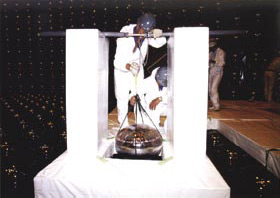Art meets science at Super-K detector
 |
|
Photo: Kamioka Observatory, ICRR (Institute for Cosmic Ray Research), The University of Tokyo |
At first glance, it seems to be another example of soulless high technology—its very name, photomultiplier tube, is devoid of poetry. Shaped like a miniature spacecraft, glowing with a mysterious golden luster, it seems to be of extraterrestrial origin.
Yet it represents the quintessence of Japanese craftsmanship. Made by Hamamatsu Photonics, each tube is handblown by a craftsman to a precision that no manufacturing technique can achieve. About 13,000 of these handcrafted electronic marvels line the walls, floor and ceiling of the mammoth Super-Kamiokande (Super-K) detector facility.
"It is like the work of the glass blowers in Venice," says Jeff Wilkes of the University of Washington, spokesman for the contingent of US scientists collaborating with their Japanese counterparts at Super-K. "But it is on a much larger scale, with tremendous attention to quality and detail."
Located in an old mine one kilometer below ground level, Super-K is one of the world's answers to the elusive neutrino, a chargeless, nearly massless particle so elusive that it can pass through a thousand miles of lead. Super-K's detector is a giant cylinder of ultra-pure water, surrounded by thousands of photomultiplier tubes. Neutrinos moving through the water with the speed of light emit an extremely faint blue glow that the tubes collect and amplify.
Commissioned in 1996, the Super-K detector enabled pioneering work on cosmic ray physics, research of dark matter, and experimental inspection of Grand Unification Theories. Then in November, 2001, disaster struck. A change in pressure, probably from a crack, caused a photomultiplier tube to implode, starting a chain reaction. In minutes, about 6000 more had burst.
After several years of tireless effort, Super-K has been fully restored and will be recommissioned in June. The photomultipliers are now in plastic shielding to prevent a repeat of the 2001 accident. The scientists have taken advantage of the restoration effort to rearrange and add more tubes for improved neutrino detection, Wilkes says.
Chandra Shekhar
Click here to download the pdf version of this article.






